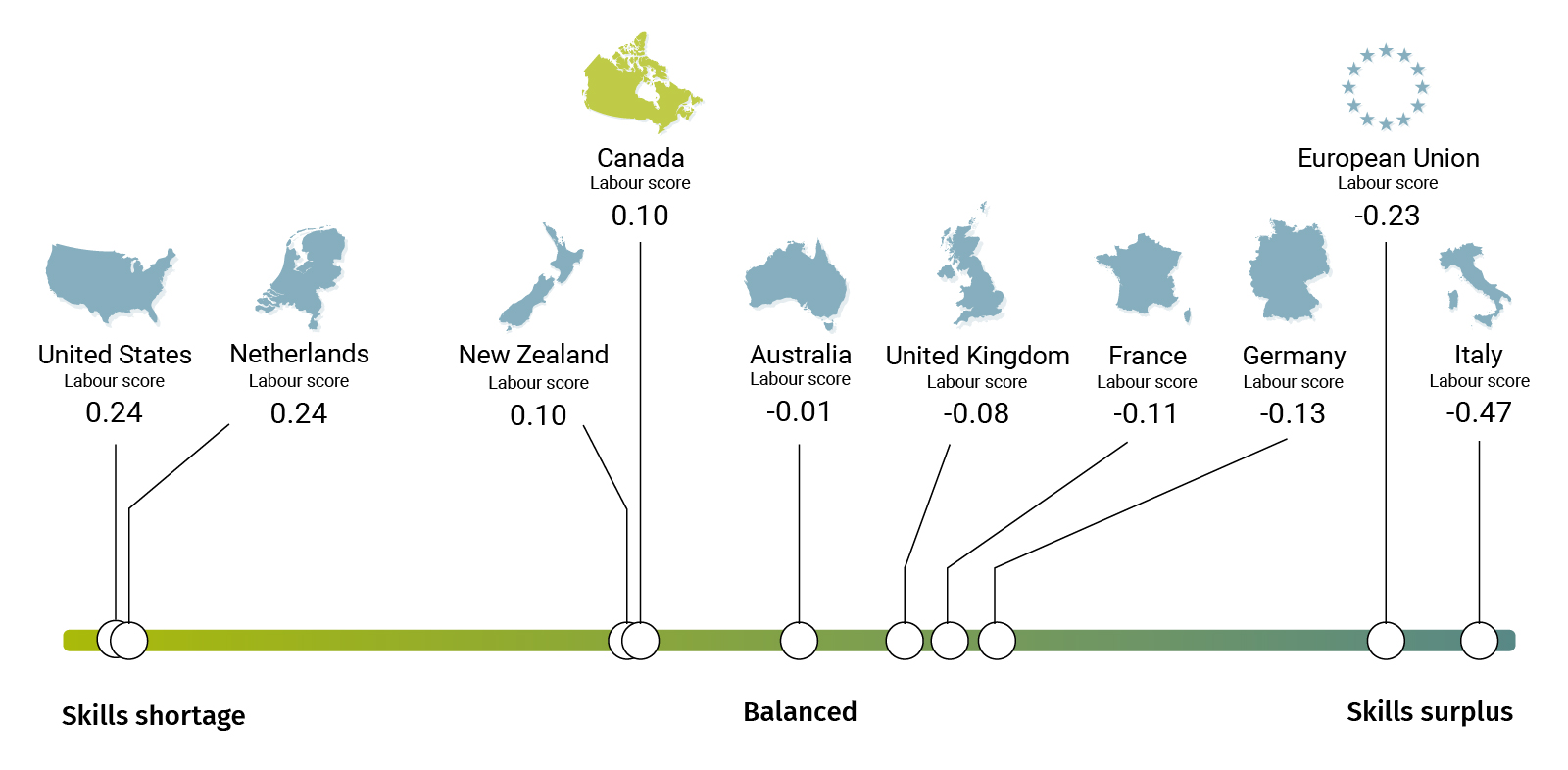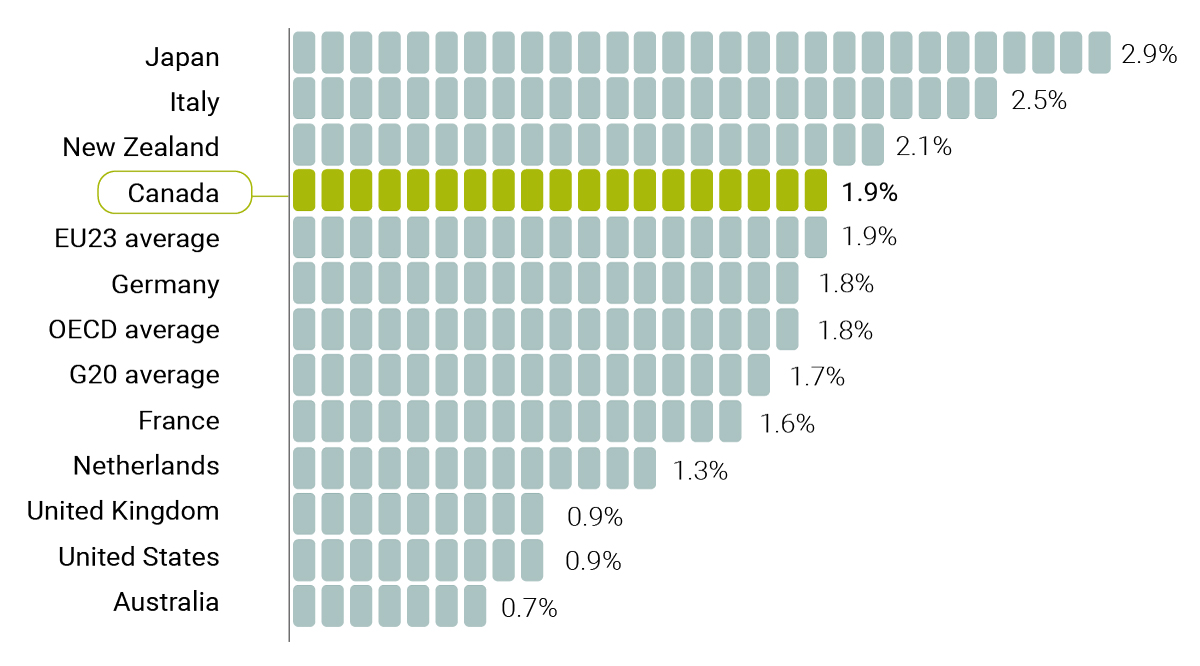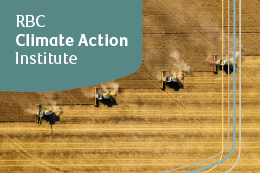Key Findings
-
 By 2033, 40% of Canadian farm operators will retire, placing agriculture on the cusp of one of the biggest labour and leadership transitions in the country’s history.
By 2033, 40% of Canadian farm operators will retire, placing agriculture on the cusp of one of the biggest labour and leadership transitions in the country’s history. -
 Over the same period, a shortfall of 24,000 general farm, nursery and greenhouse workers is expected to emerge.i
Over the same period, a shortfall of 24,000 general farm, nursery and greenhouse workers is expected to emerge.i -
 66% of producers do not have a succession plan in place, leaving the future of farmland in doubt.ii
66% of producers do not have a succession plan in place, leaving the future of farmland in doubt.ii -
 These gaps loom at a time when Canada’s agricultural workforce needs to evolve to include skills like data analytics and climate-smart practices that enable us to grow more food with fewer emissions.
These gaps loom at a time when Canada’s agricultural workforce needs to evolve to include skills like data analytics and climate-smart practices that enable us to grow more food with fewer emissions. -
 Through short-, medium-, and long-term policies, Canada can establish the digitally-savvy agricultural workforce needed to make our country a global leader in low carbon, sustainable food production.
Through short-, medium-, and long-term policies, Canada can establish the digitally-savvy agricultural workforce needed to make our country a global leader in low carbon, sustainable food production. -
 To offset a short-term skills crisis, we’ll need to accept 30,000 permanent immigrants over the next decade to establish their own farms and greenhouses or take over existing ones.
To offset a short-term skills crisis, we’ll need to accept 30,000 permanent immigrants over the next decade to establish their own farms and greenhouses or take over existing ones. -
 To meet our medium and long-term goals, we’ll need to build a new pipeline of domestic operators and workers by bolstering education and increasing the R&D spending behind productivity-enhancing automation.
To meet our medium and long-term goals, we’ll need to build a new pipeline of domestic operators and workers by bolstering education and increasing the R&D spending behind productivity-enhancing automation. -
 Other nations, like Japan and New Zealand are rapidly deploying national strategies to tackle similar challenges. They are offering incentives to farm operators who become more autonomous or unlocking pathways for foreign skilled workers and new farmers to enter their industries. Canada needs to act fast.
Other nations, like Japan and New Zealand are rapidly deploying national strategies to tackle similar challenges. They are offering incentives to farm operators who become more autonomous or unlocking pathways for foreign skilled workers and new farmers to enter their industries. Canada needs to act fast.
Canadian farmers are getting older and fewer
2001
166M acres
![]()
346,000
Avg age 50

2006
167M acres
![]()
327,000
Avg age 52

2011
160M acres
![]()
294,000
Avg age 54

2016
159M acres
![]()
272,000
Avg age 55

2021
153M acres
![]()
262,000
Avg age 56

*all bars are illustrative
Source: RBC Economics and Statistics Canadaiii
A 3-point plan for growth
- Increase immigration of farm operators by 30,000 over the next decade.
- Promote agricultural education across colleges and universities to attract new students.
- Accelerate the adoption of autonomous and mechanized solutions on farms.
Short Term:
Opening the border to new producers
Canada’s agricultural skills crisis is already one of the world’s worst. The country has one of the highest skills shortages in food production compared to other major food exporting nations-trailing only the U.S. and the Netherlands.
Canada’s shortage of agricultural workers is among the most severe

Sources: OECD Skills for Jobs Databaseiv
A rapidly approaching demographics crisis is set to make the problem worse. In 10 years, 60% of today’s farm operators will be over the age of 65. Never have so many Canadian farmers been so close to retirement. In addition, the number of operators below the age of 55 has declined by 54% since 2001.v The most immediate solution to this challenge rests at our borders. Providing permanent immigration status to over 24,000 general farm workers and 30,000 operators can assist in bridging retirement and staffing gaps, help the sector fulfill its productivity potential and meet domestic and foreign food demands.
Many farms and greenhouses are already looking to other countries to address the need for low-skilled labour. Indeed, Canada’s agricultural sector is among the most diverse in the world though the degree of demand for foreign workers differs significantly by province and operation.
The Temporary Foreign Workers program remains a critical source of low-skilled labour. But it has its disadvantages. First, it’s a provisional solution to a chronic issue. Second, many of these temporary foreign workers (TFWs) who develop skills essential to Canadian seeding and harvests, must return to their home countries for short periods. If they are unable to return to Canada (for reasons that can include their government barring the shift due to its own food security fears) then Canada’s on-farm workforce is dramatically reduced. Better policies are needed to enable the immigration of low-skilled labourers. For instance, a pathway to permanent residency for experienced TFWs will immediately address this type of shortage.
When it comes to more highly-skilled farm operators, Canada has always welcomed these types of immigrants from the Netherlands, China, United States, United Kingdom and India. But there are now valuable untapped opportunities to attract operators who have lost their farms because of regulatory policies in other nations.
In the Netherlands for instance, the government set aside €24.3 billion to buy out the 3,000 Dutch farms with the biggest emissions. Producers that do not accept the offer will be forced to close. And farms permitted to stay in operation will need to significantly reduce their nitrogen application. The country will also have to reduce its livestock population to a third of its current size over eight years. In New Zealand, a 2019 law that requires producers to reduce their emissions by 10% in the next three years is already forcing farms to scale back.
Hundreds of thousands of skilled farmers worldwide are being forced to downsize or are facing closures. In the EU alone there has been a loss of over four million farms since 2005. This is creating a labour pool of qualified farmers around the world that can help Canada grow its food exports while also adapting to stringent sustainability regulations.
The immigration of scientists, data engineers, and entrepreneurs has been recognized as critical to Canada’s growth. A similar approach needs to be adopted to attract farmers.
Medium Term:
Agricultural schools must evolve to meet today’s demands
There has been a fundamental shift in agricultural schools across Canada. As enrolment declined in the 1990s, many schools reassessed their curricula. To boost enrolment, they began to offer cross-disciplinary courses that might attract urban students less interested in working on a farm. This meant focusing on topics outside agricultural science, from food security to international development.
The approach worked. Since bottoming out in 2003, admissions have grown by more than 40%—a sign of shifting attitudes toward agricultural studies.vi Currently, Canada’s rate of post-secondary education enrolment in agricultural, forestry, fishing, and veterinary education is among the highest in the OECD, EU, and G20. Despite this, demand for graduates continues to exceed supply.vii
Canadian enrolment in agricultural education is strong
Percentage of total enrolment

Source: OECD Education at a Glance Database and RBC Economicsviii
To boost enrolment further, more needs to be done to integrate agriculture into mainstream programs. For instance, no full-time MBA program among Canada’s top 10 business schools currently offers elective courses in agribusiness. Similarly, agricultural schools don’t do enough to promote a cross-disciplinary approach that integrates students in fields ranging from engineering to social science. These innovations will be critical to increasing enrolment and developing a stronger, better-resourced agriculture ecosystem.
On the other hand, some agricultural schools and colleges are transforming into the most cross-disciplinary centres in the country as they take on topics ranging from the financial incentives to promote carbon sequestration in soil to clean energy. The Controlled Environment Systems Research Facility at the University of Guelph even works with NASA and the Canadian Space Agency to research methods of growing food on Mars.
While raising enrolment numbers, agricultural schools must also keep an eye on equipping students with the tools to put their skills to work. For example, engineering, business and computer science schools could develop more ag-related coops, case studies, and special project courses that would provide experiential education opportunities focused on food production.
Advisory services for producers
Education doesn’t stop at the school gate. Producers have historically been among the first adopters of new technology. To put even more digital skills to work they’ll need access to advisory services that can educate them on the best solutions, the most effective production practices, and the best ways to reduce costs and promote sustainability on their farms. Just as the challenges facing each farm are unique, so too are the solutions for them. Advisory services help farmers design those bespoke solutions. They also offer formal and informal workshops to farm operators and their employees. Advisory services, similar to those provided to farmers in the United States, ought to be made more publicly available to new Canadian farmers.
Long Term:
Introducing more mechanized and autonomous solutions on the farm
Automation has been a core theme in agriculture for centuries. Most machinery and tools today are equipped with technologies that increase efficiencies on every acre. And producers that invest in technology tend to be more profitable. In 2020, over 50% of farms investing in new technology noted a decrease in costs. And while automation reduces the need for on-farm labour it also creates new jobs for highly skilled workers. The introduction of the tractor, self-propelled combine, and auto-steer are among the milestones in on-farm innovation and productivity.
Smart agriculture technology and practices will promote higher levels of efficiency, increase productivity, limit environmental impact, and promote sustainability. Just as important, these innovative solutions can reduce the need for low-skilled labour.
A lot of this innovative technology is already being developed in Canada. But more ambitious research and development is critical to cutting staffing needs and improving production rates and sustainability. This begins with funding. In Canada, agricultural R&D dollars predominantly originate from public sources. We should strive to be more ambitious with funding as every dollar invested in R&D generates $10 to $20 in GDP.ix As production intensifies on farms, more tools to decrease emissions autonomously will be needed.
Canadian public funding for agricultural R&D lags global peers
Millions $USD
RBC Economics, OECD, and Stats Canada
Public investments represent the largest source of funding for Canada’s agriculture R&D at CAD $ 450 million in 2020, but private in-house R&D lags by comparison at CAD $108 million.xxi And Canadian firms invest less on average in R&D than foreign firms. Corporations have contributed significantly to past innovations that ease labour shortages while making agricultural production more resilient to extreme weather events and improving quality and sustainability. However, for Canada to become the world’s most reliable and sustainable food exporter, further investments will be needed.
R&D can spur growth in the sector, but distribution among producers will be critical. Though capital expenditure in agriculture has risen faster than in other Canadian industries over the last 15 years the largest investments have been among crop producers.
Canadian agricultural firms trail global competitors in R&D spending
Expenditures as a percentage of revenues
2018
1.2%
Canada
5.2%
Foreign
2019
1.0%
Canada
3.8%
Foreign
2020
1.4%
Canada
4.6%
Foreign
RBC Economics, Statistics Canadaxii
World Comparison
Canada is not the only nation facing a labour and skills gap in its agriculture sector. These countries have already taken action to address shortages through unique policy programs:
![]() Japan
Japan
The average age of a Japanese farmer is 68, making it the country with the biggest agricultural leadership challenge in the OECD. To ensure young farm operators enter the sector, the government provides them with income support for five years upon establishing their own farms. In addition, the launch of the Smart Agriculture program provides free advisory services for how to implement autonomous and mechanized solutions. The country has also established “pilot villages” that can demonstrate the effectiveness of new technologies.xiii
![]() New Zealand
New Zealand
New Zealand is struggling to get young people and new producers to enter the sector. In 2014, the Primary Industry Alliance was formed among producers, universities, colleges, and public officials.xiiv The agriculture component of the program focuses on attracting new farmers through education and immigration. In addition, the government has engaged with the Māori community to increase its participation in the industry.
![]() The Netherlands
The Netherlands
Over 530,000 migrant workers are employed across the Dutch agriculture sector.xv While the Netherlands is increasingly reliant on these migrant labourers, it wants to increase its share of highly-skilled workers. To confront this challenge, the government established the Strategy for Green Education to attract students to the industry and coordinate education institutes to meet the labour needs of the sector.
![]() The United States
The United States
Like Canada, the U.S. relies heavily on temporary labourers. However, as the rate of farm operators has declined, the demand for labour has only grown. There is funding for agricultural education programs in secondary schools and support for land-grant universities that offer advisory services to farmers. But the labour crunch is nevertheless forcing the average wage higher and has prompted many producers to invest in autonomous solutions.
Conclusion
The agriculture sector is facing a transformational skills and labour crisis. However, with the right approach, this acute disadvantage can become a generational advantage. By increasing the immigration of skilled farmers, encouraging colleges and universities to bring students of all backgrounds into the sector, and investing in innovative solutions to automate and reduce on-farm labour, Canada can lead the world into a new era of low carbon farming.
Budget 2023 was an opportunity to set ambitious goals that capitalize on Canada’s natural advantages in agriculture. While many of the measures unveiled provide temporary relief to various issues, the budget lacked a comprehensive vision for the sector’s future and the climate challenges it is encountering. The opportunity is there for farmers, governments and the broader agricultural supply chain to work together on this issue.
Meeting these challenges will demand a whole new approach that includes the participation of all of these stakeholders.
Success factors
For more, go to rbc.com/the-next-green-revolution-project.

Download the Report
Contributors:
Lead author: Mohamad Yaghi, Agriculture and Climate Policy Lead, RBC
RBC
Naomi Powell, Managing Editor, Economics and Thought Leadership
Farhad Panahov, Economist
Carrie Freestone, Economist
Darren Chow, Senior Manager, Digital Media
Shiplu Talukder, Digital Publishing Specialist
Gwen Paddock, Director, Sustainability & Climate – Agriculture
Boston Consulting Group
Youssef Aroub, Project Leader
Keith Halliday, Senior Director, Centre for Canada’s Future
Chris Fletcher, Managing Director and Partner
Thomas Foucault, Managing Director and Partner
Shalini Unnikrishnan, Managing Director and Partner
Sonya Hoo, Managing Director and Partner
Pilar Pedrinelli, Expert Consultant
Arrell Food Institute, University of Guelph
Evan Fraser, Director
Ibrahim Mohammed, Ph.D. Candidate, Environmental Sciences
Deus Mugabe, Ph.D. Candidate, Plant Agriculture
Lisa Ashton, Ph.D. Candidate
- Dr. Joy Agnew, Associate VP of Applied Research, Olds College
- Christopher Johnson, Senior Development Partner, Olds College
- Dr. Danny Le Roy, Associate Professor of Economics, University of Lethbridge
- Jeanna Rex, Arrell Food Institute, Education Coordinator, Arrell Food Institute at the University of Guelph
- Beverly Agar, Senior Relationship Manager, Agriculture and Agri-Business, RBC
- Employment and Social Development Canada and RBC Economics,
- Statistics Canada 2021 Agricultural Census and RBC Economics,
- Statistics Canada 2021 Agricultural Census and RBC Economics,
- RBC Economics and OECD Skills for Jobs Database,
- Statistics Canada 2021 Agricultural Census and RBC Economics,
- Statistics Canada 2021 Agricultural Census and RBC Economics,
- OECD Education at a Glance Database and RBC Economics,
- OECD Education at a Glance Database and RBC Economics,
- Agricultural Institute of Canada, “An Overview of the Canadian Agricultural Innovation System.”
- Statistics Canada, and RBC Economics,
- Statistics Canada and RBC Economics,
- Statistics Canada, OECD Statistics, and RBC Economics.
- “Labour and skills shortages in the agro-food sector”, OECD Food, Agriculture and Fisheries Papers, No. 189, OECD Publishing, Paris, https://doi.org/10.1787/ed758aab-en.
- “Labour and skills shortages in the agro-food sector”, OECD Food, Agriculture and Fisheries Papers, No. 189, OECD Publishing, Paris, https://doi.org/10.1787/ed758aab-en.
- “Labour and skills shortages in the agro-food sector”, OECD Food, Agriculture and Fisheries Papers, No. 189, OECD Publishing, Paris, https://doi.org/10.1787/ed758aab-en.
This article is intended as general information only and is not to be relied upon as constituting legal, financial or other professional advice. The reader is solely liable for any use of the information contained in this document and Royal Bank of Canada (“RBC”) nor any of its affiliates nor any of their respective directors, officers, employees or agents shall be held responsible for any direct or indirect damages arising from the use of this document by the reader. A professional advisor should be consulted regarding your specific situation. Information presented is believed to be factual and up-to-date but we do not guarantee its accuracy and it should not be regarded as a complete analysis of the subjects discussed. All expressions of opinion reflect the judgment of the authors as of the date of publication and are subject to change. No endorsement of any third parties or their advice, opinions, information, products or services is expressly given or implied by Royal Bank of Canada or any of its affiliates. This document may contain forward-looking statements within the meaning of certain securities laws, which are subject to RBC’s caution regarding forward- looking statements. ESG (including climate) metrics, data and other information contained on this website are or may be based on assumptions, estimates and judgements. For cautionary statements relating to the information on this website, refer to the “Caution regarding forward-looking statements” and the “Important notice regarding this document” sections in our latest climate report or sustainability report, available at: https://www.rbc.com/community-social- impact/reporting-performance/index.html. Except as required by law, none of RBC nor any of its affiliates undertake to update any information in this document.


